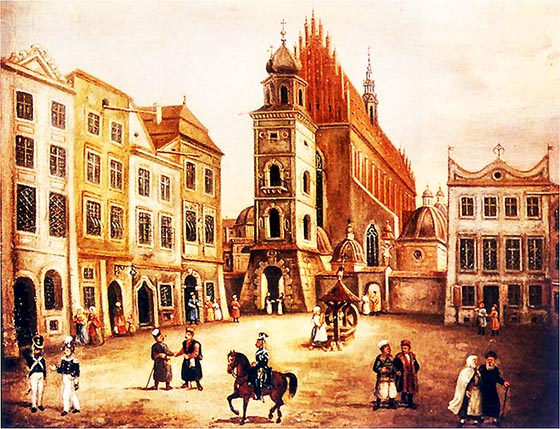 Twórca zakonu dominikanów byt Dominik de Guzman, od którego imienia zgromadzenie wzięło swoja potoczna nazwę. Początkiem XIII w, w całej Europie szerzyły się herezje (katarzy, waldensi itd.), więc Dominik wystąpił z pomysłem utworzenia specjalnego zakonu do ich zwalczania. Ordo Praedicatorum – czyli Zakon Kaznodziejski odbył swój synod założycielski w 1220 r. a już dwa lata później utworzono klasztor w Krakowie (1222 r.). Organizatorem klasztoru krakowskiego byt św. Jacek. Zgromadzenie miało być zakonem miejskim I żebraczym (identycznie jak franciszkanie), ale nikt nie przywiązywał do tego specjalnej wagi. W istocie zakon dać miał Kościołowi sprawnych, wykształconych ludzi, przygotowanych do ciężkiej walki o odzyskanie utraconych dusz. Wkrótce brać mnichowska rozszyfrowała ich nazwę jako Domini canes – psy Pańskie. Dominikanie zaakceptowali tę nazwę, nawet z niejaka duma, gdyż określenie trafiało w sedno ich specyfiki.
Twórca zakonu dominikanów byt Dominik de Guzman, od którego imienia zgromadzenie wzięło swoja potoczna nazwę. Początkiem XIII w, w całej Europie szerzyły się herezje (katarzy, waldensi itd.), więc Dominik wystąpił z pomysłem utworzenia specjalnego zakonu do ich zwalczania. Ordo Praedicatorum – czyli Zakon Kaznodziejski odbył swój synod założycielski w 1220 r. a już dwa lata później utworzono klasztor w Krakowie (1222 r.). Organizatorem klasztoru krakowskiego byt św. Jacek. Zgromadzenie miało być zakonem miejskim I żebraczym (identycznie jak franciszkanie), ale nikt nie przywiązywał do tego specjalnej wagi. W istocie zakon dać miał Kościołowi sprawnych, wykształconych ludzi, przygotowanych do ciężkiej walki o odzyskanie utraconych dusz. Wkrótce brać mnichowska rozszyfrowała ich nazwę jako Domini canes – psy Pańskie. Dominikanie zaakceptowali tę nazwę, nawet z niejaka duma, gdyż określenie trafiało w sedno ich specyfiki.
Mnisi w pięknych biało-czarnych habitach stali się postrachem kacerzy i wolnomyślicieli. W ich rękach znalazł się prawie cały aparat św. Inkwizycji i św. Oficjum w Rzymie i to aż do kresu istnienia tych instytucji. Godłem zakonu jest leżący pies trzymający w pysku gorejącą pochodnię.
Z czasem dominikanie stali się intelektualną elitą Kościoła. Długo można by się rozwodzić nad ich niezmiennie wysokim poziomem intelektualnym i kulturalnym oraz zasługami (dominikaninem był np. Tomasz z Akwinu, największy filozof średniowiecza). Z drugiej strony dominikanami byli: Jan Falkenberg, wynajęty przez Krzyżaków autor oszczerczych traktatów przeciw Polsce i Jagielle oraz inkwizytor Jakób Sprenger – autor osławionego Młota na czarownice (książki niemal natychmiast wydanej w Krakowie, na szczęście nie cieszącej się tu popularnością).
W latach 80. naszego stulecia krużganki krakowskiego klasztoru udzieliły schronienia Ruchowi Odnowy w Duchu Sw. przy duszpasterstwie akademickim – „Beczka”, który niezwykle rozbudził (czasami nawet za bardzo) świadomość i życie religijne młodzieży „wokół-akademickiej”. Ruch ten dążył do odnowy religijności, m.in. przez ponowne wprowadzenie niektórych dawnych rytuałów i obrzędów z początków chrześcijaństwa, jak modlitwa z wzniesionymi ramionami, taniec ekstatyczny, specjalne nocne nabożeństwa w plenerze, kolejne kręgi „wtajemniczenia”. Duch Święty podczas spotkań modlitewnych obdarzał uczestników swoimi „darami” – zdolnością mówienia różnymi językami ludzkimi i anielskimi, darem proroctwa, uzdrawiania przez nałożenie rąk itp. Wszystko to działo się z wiedzą i aprobata pobliskiej (100 m) Kurii Arcybiskupiej i pod czuwającym nad prawowiernością, profesjonalnym okiem dominikanów. W pewnym momencie jednak ruch posunął się nieco za daleko i Kościół cofnął mu swój protektorat. Część najbardziej zaangażowanych uczestników odeszła do kościołów zielonoświątkowych i grup charyzmatycznych, kilku spróbowało założyć nowe sekty, reszta wróciła na łono ortodoksji.
